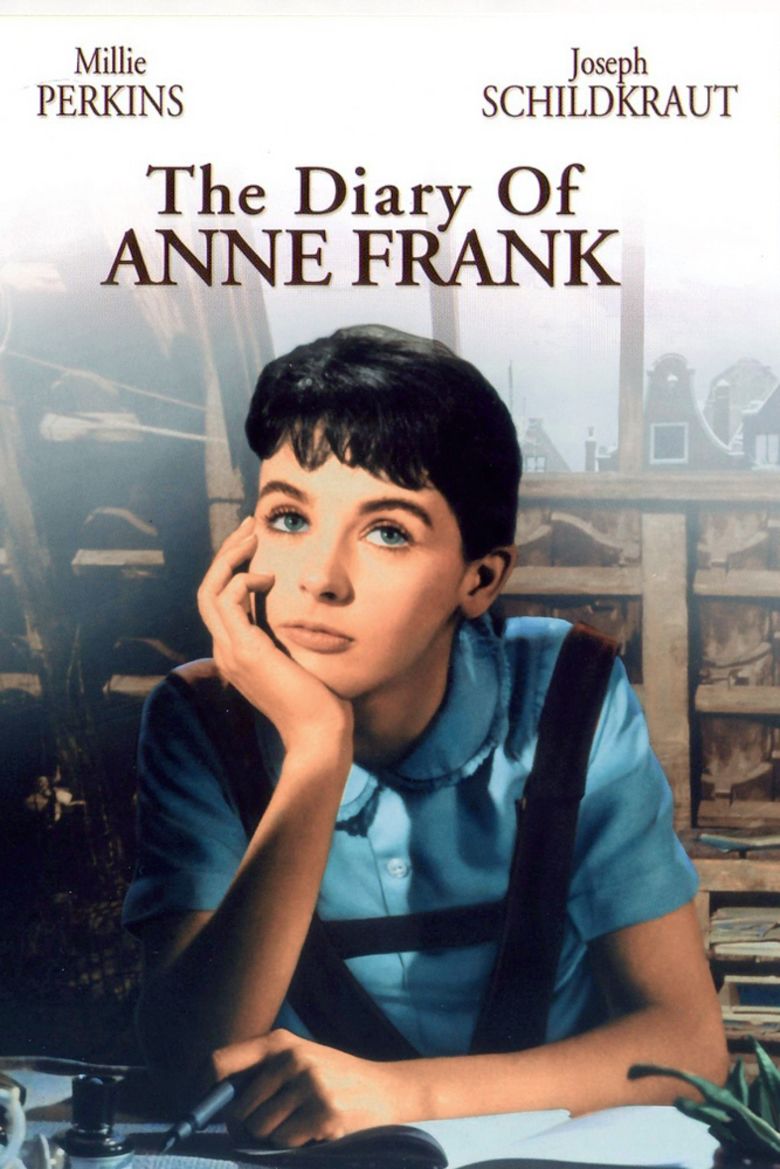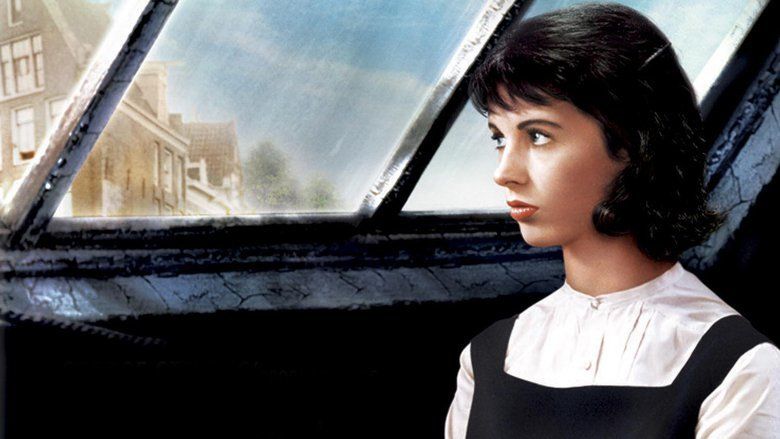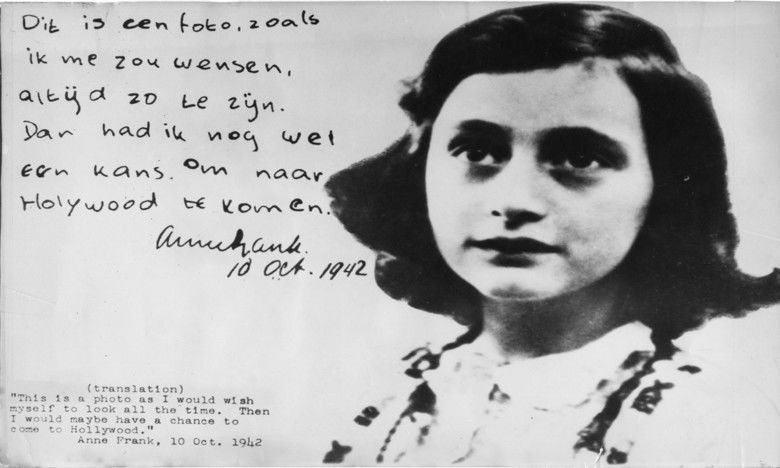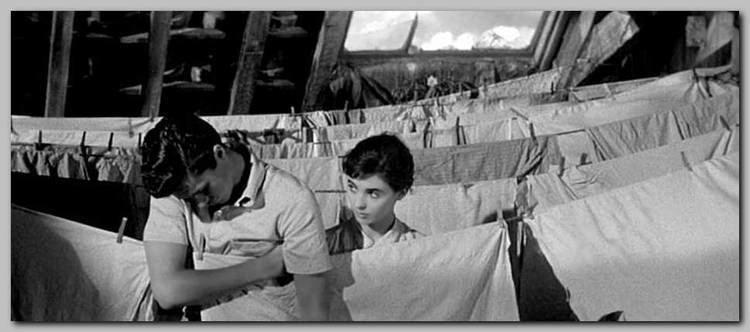The Diary of Anne Frank (1959 film)
7.6 /10 1 Votes
76% Rotten Tomatoes Genre Biography, Drama, Family Language EnglishGerman | 7.4/10 IMDb Duration Country United States | |||||||||||||||||||||||||||||||||
 | ||||||||||||||||||||||||||||||||||
Release date March 18, 1959 (1959-03-18) Based on The diary ofAnne Frank byFrances GoodrichAlbert HackettThe Diary of aYoung Girl byAnne Frank Awards Academy Award for Best Actress in a Supporting Role Cast (Anne Frank), (Otto Frank), (Auguste Van Pels), (Peter Van Pels), (Edith Frank-Holländer), (Hermann Van Pels) Similar movies The Book Thief , Saving Private Ryan , The Diary of Anne Frank , Max Manus: Man of War , The Pianist , J. Edgar | ||||||||||||||||||||||||||||||||||
The diary of anne frank 1959 trailer
In Nazi-occupied Holland in World War II, shopkeeper Kraler hides two Jewish families in his attic. Young Anne Frank (Millie Perkins) keeps a diary of everyday life for the Franks and the Van Daans, chronicling the Nazi threat as well as family dynamics. A romance with Peter Van Daan causes jealousy between Anne and her sister, Margot. Otto Frank (Joseph Schildkraut) returns to the attic many years after the eventual capture of both families and finds his late daughters diary.
Contents
- The diary of anne frank 1959 trailer
- Plot
- Cast
- Origin
- The shooting
- Premiere
- Academy Awards
- Film festivals
- Home media
- References

The Diary of Anne Frank is a 1959 film based on the Pulitzer Prize winning play of the same name, which was based on the diary of Anne Frank. It was directed by George Stevens, with a screenplay by Frances Goodrich and Albert Hackett. It is the first film version of both the play and the original story, and features three members of the original Broadway cast.

The film was based on the personal diary of Anne Frank, a Jewish girl who lived in hiding with her family during World War II. All her writings to her diary were addressed as Dear Kitty. The diary was published after the end of the war by her father Otto Frank (played by Joseph Schildkraut, also Jewish). By this time, all his other family members had been killed by the Nazis. The movie was shot on a sound stage duplicate of the factory in Los Angeles, while exteriors were filmed at the actual building in Amsterdam.

The Diary of Anne Frank won three Academy Awards in 1960, including Best Supporting Actress for Shelley Winters. In 2006, The Diary of Anne Frank was honored as the eighteenth most inspiring American film on the list AFIs 100 Years…100 Cheers.
Harrowing story of a young Jewish girl who, with her family and their friends is forced into hiding in an attic in Nazi-occupied Amsterdam.
Plot

In 1945, as a truckload of war survivors stops in front of an Amsterdam factory at the end of World War II, Otto Frank (Joseph Schildkraut) gets out and walks inside. After climbing the stairs to a deserted garret, Otto finds a girls discarded glove and sobs, then is joined and comforted by Miep Gies (Dodie Heath) and Mr. Kraler (Douglas Spencer), factory workers who shielded him from the Nazis. After stating that he is now all alone, Otto begins to search for the diary written by his youngest daughter, Anne. Miep promptly retrieves the journal for Otto, and he receives solace reading the words written by his young daughter three years earlier.

The action moves to July 1942, and Anne (Millie Perkins) begins by chronicling the restrictions placed upon Jews that drove the Franks into hiding over the spice factory. Sharing the Franks hiding place are the Van Daans (Lou Jacobi and Shelley Winters) and their teenage son, Peter (Richard Beymer). Kraler, who works in the office below, and Miep, his assistant, have arranged the hideaway and warn the families that they must maintain strict silence during daylight hours while the workers are there. On the first day, the minutes drag by in silence. After work, Kraler delivers food and a box for Anne compiled by her father, which contains her beloved photos of movie stars and a blank diary. In the first pages of the diary, Anne describes the strangeness of never being able to go outside or breathe fresh air. It states that everybody is good at heart.

As the months pass, Annes irrepressible energy reasserts itself and she constantly teases Peter, whose only attachment is to his cat, Moushie. Isolated from the world outside, Otto schools Anne and Margot (Diane Baker) as the sounds of sirens and bombers frequently fill the air. Mrs. Van Daan passes the time by recounting fond memories of her youth and stroking her one remaining possession, the fur coat given to her by her father. The strain of confinement causes the Van Daans to argue and pits the strong-willed Anne against her mother (Gusti Huber). One day, Kraler brings a radio to the attic, providing the families with ears onto the world. Soon after, Kraler asks them to take in another person, a Jewish dentist named Albert Dussell (Ed Wynn). When Van Daan complains that the addition will diminish their food supply, Dussell recounts the dire conditions outside, in which Jews suddenly disappear and are shipped to concentration camps. When Dussell confirms the disappearance of many of their friends, the families hopes are dimmed.
One night, Anne dreams of seeing one of her friends in a concentration camp and wakes up screaming. In October 1942, news comes of the Allied landing in Africa, but rather than producing relief, the bombing outside the factory intensifies, fraying the refugees already ragged nerves. During Hanukkah, Margot longingly recalls past celebrations and Anne produces little presents for everyone. When Van Daan abruptly announces that Peter must get rid of Moushie because he consumes too much food, Anne protests. Their argument is cut short when they hear a prowler break in the front door and the room falls silent. Peter then sends an object crashing to the floor while trying to catch Moushie, and the startled thief grabs a typewriter and flees. A watchman notices the break-in and summons two Gestapo officers, who search the premises, shining their flashlights onto the bookcase that conceals the attic entrance. The families wait in terror until Moushie knocks a plate from the table and meows, reassuring the officers that the noise was caused by a common cat. After the officers leave, Otto, hoping to foster faith and courage, leads everyone in a Hanukkah song.
In January 1944, Anne, on the threshold of womanhood, begins to attract Peters attention. When Miep brings the group a cake, Dussell and Van Daan bicker over the size of their portions and then Van Daan asks Miep to sell his wifes fur coat so that he can buy cigarettes. After Kraler warns that one of his employees asked for a raise and implied that something strange is going on in the attic, Dussell dourly comments that it is just a matter of time before they are discovered. Anne, distraught, blames the adults for the war which has destroyed all sense of hope and ideals. When she storms out of the room, Peter follows and comforts her. Later, Anne confides her dreams of becoming a writer and Peter voices frustration about his inability to join the war effort. In April 1944, amid talk of liberation, the Franks watch helplessly as more Jews are marched through the streets. Tensions mount, and when Van Daan tries to steal some bread from the others, Edith denounces him and orders him to leave. As Dussell and Van Daan quarrel over food, word comes over the radio of the Normandy invasion and Van Daan breaks into tears of shame. Heartened by the news, everyone apologizes for their harsh words, and Anne dreams of being back in school by the fall.
By July 1944, the invasion has bogged down and Kraler is hospitalized with ulcers. Upon hearing that the Gestapo has found the stolen typewriter, Anne writes that her diary provides her with a way to go on living after her death. After the Van Daans begin to quarrel once more, Peter declares that he cannot tolerate the situation and Anne soothes him by reminding him of the goodness of those who have come to their aid. Their conversation is interrupted by the sirens of an approaching Gestapo truck. As Anne and Peter bravely stand arm in arm, certain of their impending arrest, they passionately kiss. As the German soldiers break down the bookcase entrance to the hideout, Otto declares they no longer have to live in fear, but can go forward in hope.
The film returns to 1945 as Otto tells Miep and Kraler that on his long journey home after his release from the concentration camp he learned how Edith, Margot, the Van Daans, and Dussell perished, but always held out hope that perhaps Anne had somehow survived. Otto sadly reveals that only the previous day in Rotterdam he met a woman who had been in Bergen-Belsen with Anne and confirmed her death. Otto then glances at Annes diary and reads, "In spite of everything, I still believe that people are really good at heart," and is left in total shame.
Cast
Otto Frank personally wrote to Audrey Hepburn, asking her if she would play the part of his daughter Anne. Frank told Hepburn that his daughter would have been honoured to have such a famous Hollywood actress play her on film, and he also noted the striking resemblance that existed between Anne and Hepburn when she was an adolescent. Hepburn wrote back declining the offer, saying she felt she was too old, and lacked the skills to portray Anne. She said she was greatly honoured to have been given the choice, and noted the similarity between her own war experience and that of the Franks and the others in the annex.
Origin
The shooting
Premiere
The film premiered March 18, 1959, at the Palace Theatre in New York City.
Academy Awards
The film won three Academy Awards:
It was nominated for a further five:
American Film Institute recognition
Film festivals
The film was entered into the 1959 Cannes Film Festival and the 1st Moscow International Film Festival.
Home media
The Diary of Anne Frank was first released on DVD on February 3, 2004. The special features included some of the following; "The Diary of Anne Frank: Echoes From the Past" featurette, a press conference with director George Stevens, MovieTone news announcing public appearances by Millie Perkins, a screen test, and an audio commentary by Millie Perkins and George Stevens Jr, the directors son.
A fiftieth-anniversary edition of the film was released on DVD and Blu-ray on June 16, 2009, three months after the films actual release anniversary, in commemoration of what would have been Anne Franks 80th birthday. It included seven major new featurettes: three cast interviews, a behind-the scenes look at the score, two short documentaries about George Stevens memories from the war and the history of the diary, and a perspective piece on the films legacy by Thomas Rothman.
The Blu-ray release was only a month before Tony van Renterghem died on July 19. Renterghem, a Dutch cinematographer and technical, historical and script adviser who worked with Stevens for many years, consulted on both the play and the film. While his work was almost entirely behind the scenes, his knowledge no doubt helped in putting together the historical featurettes.
References
The Diary of Anne Frank (1959 film) WikipediaThe Diary of Anne Frank (1959 film) IMDbThe Diary of Anne Frank (1959 film) Rotten TomatoesThe Diary of Anne Frank (1959 film) themoviedb.org
